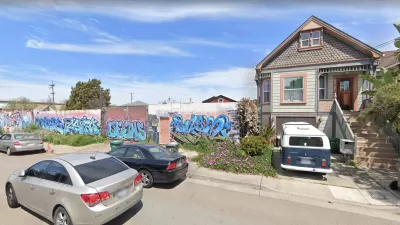In Oakland, California and Torreon, New Mexico, Julian Brave NoiseCat reports that "[f]or Indigenous people, the crisis of the home is intergenerational."
At High Country News, Julian Brave NoiseCat profiles the struggle of many members of the same extended family to find and keep somewhere to live in two very different places; Native Americans, he writes, are "this continent's first victims of gentrification."
The piece begins in Oakland with Joseph Waukazoo, who has no place to live, and as an "urban Indian" belongs to "a demographic that has no place in the public imagination." It ends in Torreon, New Mexico, where his ex-wife, his son and their extended family survive in a very different landscape that nonetheless has some of the basic flaws.
"The housing crisis is one of the most-discussed global political, economic and social problems of our time. Yet people like the Waukazoos rarely feature in any of its narratives. The politicians, pundits and professors focused on the urban housing crisis overlook or omit urban Indians. Meanwhile, housing problems on reservations are equally out of the frame. In an era of inequality, the Waukazoos—struggling for visibility, dignity and basic housing security—represent some of the most forgotten of our nation’s forgotten people."
The "death spiral" of rising demand for housing in the Bay Area and the homelessness on rural reservations are both well-documented, but NoiseCat ties them together.
"For Indigenous people, the crisis of the home is intergenerational. This is what scholars, policymakers and even activists too often misunderstand about the housing crisis: Today’s problems do not represent momentary inequities. They are structural constants, deeply rooted in the system. They cut into Indigenous families over generations, not just economic and political cycles."
FULL STORY: A tale of two housing crises, rural and urban

Study: Maui’s Plan to Convert Vacation Rentals to Long-Term Housing Could Cause Nearly $1 Billion Economic Loss
The plan would reduce visitor accommodation by 25,% resulting in 1,900 jobs lost.

North Texas Transit Leaders Tout Benefits of TOD for Growing Region
At a summit focused on transit-oriented development, policymakers discussed how North Texas’ expanded light rail system can serve as a tool for economic growth.

Using Old Oil and Gas Wells for Green Energy Storage
Penn State researchers have found that repurposing abandoned oil and gas wells for geothermal-assisted compressed-air energy storage can boost efficiency, reduce environmental risks, and support clean energy and job transitions.

Private Donations Propel Early Restoration of Palisades Playground
Los Angeles has secured over $1.3 million in private funding to restore the Pacific Palisades playground months ahead of schedule, creating a modern, accessible space that supports community healing after recent wildfires.

From Blight to Benefit: Early Results From California’s Equitable Cleanup Program
The Equitable Community Revitalization Grant (ECRG) program is reshaping brownfield redevelopment by prioritizing projects in low-income and environmental justice communities, emphasizing equity, transparency, and community benefits.

Planting Relief: Tackling Las Vegas Heat One Tree at a Time
Nevada Plants, a Las Vegas-based nonprofit, is combating the city’s extreme urban heat by giving away trees to residents in underserved neighborhoods, promoting shade, sustainability, and community health.
Urban Design for Planners 1: Software Tools
This six-course series explores essential urban design concepts using open source software and equips planners with the tools they need to participate fully in the urban design process.
Planning for Universal Design
Learn the tools for implementing Universal Design in planning regulations.
Ascent Environmental
Borough of Carlisle
Institute for Housing and Urban Development Studies (IHS)
City of Grandview
Harvard GSD Executive Education
Toledo-Lucas County Plan Commissions
Salt Lake City
NYU Wagner Graduate School of Public Service





























